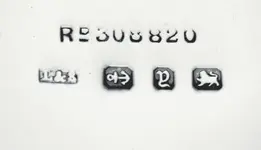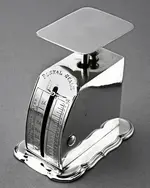Did anyone notice the picture that has H.M somewhat near the other three hallmarks it did I forget to post that pic I’m sure I mentioned it. That must be the maker and the fourth element
Sorry, but no. I don't know what the 'H.M.' stands for but... just to try and explain one more time. This is a Brookes & Crookes (of Sheffield) hallmark. As I said they are reported to have made at least some solid silver items, but were not renowned for it. In addition to those marks, there would also be a date letter (not shown here) and it's usually the last symbol in the sequence.

Note that it has a crown (the city assay mark for Sheffield) and the lion 'passant guardant' (the purity indication for silver) together with the maker's mark. They don't have to be in that order. Together with the date letter these are the four marks you should expect to see on silver... and the maker's mark may require more than one 'icon'.
The city assay mark and the purity mark are what are known as '
compulsory marks'. That is, they
must both be present on silver items. Your piece has
no city mark (the crown) for Sheffield.
If it was assayed in another town/city then it would carry the mark for that town/city. In the time period for which we know this piece was made (because the postal rates can be reliably dated) we can determine what the marks should have been for any of the towns/cities which might have assayed it.
Your piece does not carry any of these marks.
There are in fact only a limited number of possibilities since we only had a limited number of assaying town/cities. You can view them all here:
https://www.silvermakersmarks.co.uk/index.htm
Unless you have an
exact match for one of those town/city marks (including the shape of the shield on which it is placed) and which also fits the time period for the piece then it's
not a hallmark and the piece is not silver. It's a pseudo-hallmark for silver plate.
As I have already said, the use of the crown mark was prohibited by law on silver plate from 1896 onwards and could only be used on solid silver. That, for sure will be reason it's missing from this piece. It's still an attempt to 'pass off' the piece as silver to anyone without the knowledge to know the difference, but not an illegal mark as such. Just sharp practice (and dozens of silver plate manufacturers did the same until further legislation and codes of practice put a stop to it).






